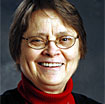About six years ago at a Hymn Society meeting I was talking with some people and noted that I was getting old and didn’t have the kind of inspiration I had as a kid where I could sit up all night writing.
If you gave me a specific assignment, on the other hand, I would get to it in the morning.
With that I sat down next to someone — it turned out to be Wayne Leupold, a publisher of hymn texts and music — who turned to me and said, “Well I have an assignment for you. Write a hymn on every lesson in the Revised Common Lectionary. Could you do that?” “Sure,” I said.
A brief encounter, one of those moments that opens a new door behind which there is new life.
That was July 2004. I was on sabbatical that fall and in Scandinavia until November. When I got back, Wayne called and asked, “Are you still up for the assignment?” “Yes,” I replied, “but I’ve learned something: the hymns will preach.” “Huh?” “It’s too much to explain,” I said, “you won’t notice the difference, but I will.”
Instead of being creative in my praise of God, now I was going to try to bring the wonders of God into the daily life of those who sang. It was a major difference.
I had learned something on my sabbatical while I was in Jutland, Denmark, where Hans Adolph Brorson (1694-1764), the writer of “Your Little Ones Dear Lord Are We” and “Who is this Host Arrayed in White,” had been born and spent his life as pastor, hymn writer, bishop and mystic. Brorson’s hymns were written to put Christ back into Christmas and the subject of my research.
On my walks around the heaths, fragrant with grasses, wild roses and the salt air of the North Sea, I found that what I saw and experienced around me appeared in his hymns. As I walked around his landscape and read his hymns, I made what most people might think was a basic and late discovery: Duh! Danish hymns were filled with Danish landscapes.
The English tradition of hymnody is rooted in biblical paraphrases à la John Calvin, Isaac Watts, and the praise songs of the Wesleys. All noble and glorious traditions, but it felt to me like the Lutheran hymn in English hadn’t really made it across the ocean.
I looked again at Luther — his hymns were proclamations of Scripture, not paraphrases, and most of them were addressed to the congregation in the language of the day — one hears medieval knights clashing in his greatest, “A Mighty Fortress is Our God.”
Simply moving around biblical phrases in some kind of creative mix didn’t interest me. If, however, the task was to find language that responded to the Scripture and used it to describe how Christ was active in my experience of the faith, then that was another matter.
Indeed, it seems to me what Christian education and nurture should be all about — teaching children to express themselves in biblical stories. My uncle used to say the hard part about preaching was getting Jesus from ancient Palestine to Fargo. That is the essence of the business of the preacher, but it is hard to teach especially now that people are not steeped in Scripture the way they once were.
We try to teach students how to do this in seminary. I taught a course once called Writing for Ministry. The content was Psalm 46, and the assignments were to translate it, paraphrase it, exegete it, then, finally to use it to describe one’s walk near the Mississippi. The students were all quite capable in the first assignments, but the last one baffled them and seemed terribly difficult. That fascinated me, as it seems that that final move — to see the Scriptures in everyday life — is the essence of the preacher’s task.
It is what all preachers do every week. Now I’ve done it regularly for six years now, as well, though through song rather than sermon. After a week of study, I retire to my living room on Saturday night, and like all preachers, try to get Jesus into contemporary contexts, landscapes and situations. The basic sermonic task is interpreting Scripture for the hearers and for this moment, not all time.
It may be that a hymn text that speaks most movingly to one age may or may not transcend that generation. And that’s okay; transcending the ages is not my concern as I sit on my couch writing hymns.
What I want to do is speak effectively to the current context with its worries and terrors and joys. I want to show how Jesus and God’s Word are present in our daily lives. The musicians have been trying to do this with their music, but simply repeating biblical phrases to contemporary music may have turned out not to have been interpretive enough for the young who need to know how this stuff works in real life.
So now I have six booklets of hymns, three on the Gospels, three on the Old Testament lessons, and now one-third of the first of the Epistles books. (See WayneLeupold.com for A Treasury of Faith.) At the end, I will have nine booklets, and maybe a couple more for the festivals and extra days
This summer at the Hymn Society convention,
a book with the tunes by Dan Damon for the Matthew hymns will be released. By that time the Mark hymns will be set by Amanda Husberg. One of the real pleasures is how refreshing and exciting it is to get a sheaf of tunes for these texts and see how they reveal the strengths and weaknesses of my texts. It helps as I write new ones.
The best surprise is how rich it is for me spiritually in my daily walk with the Lord. To think an off-hand comment one summer day at St. John’s University should have opened this door in me in my later years when I thought I had few new challenges ahead of me. To quote William Cowper, an Englishman who did preach in his hymns, “Sometime a light surprises a Christian when he sings.”

